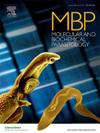Impact of dandelion (Taraxacum officinale) leaf aqueous extract on immunological response of mice after Schistosoma mansoni infection
IF 1.4
4区 医学
Q4 BIOCHEMISTRY & MOLECULAR BIOLOGY
引用次数: 0
Abstract
This study investigated the effect of dandelion (Taraxacum officinale) leaf aqueous extract (DLE) on the immunological response of mice following infection with Schistosoma mansoni. Mice (in groups of 7) were first experimentally infected with S. mansoni and, 6 weeks later, were treated with praziquantel (PZQ) and/or DLE. Control mice were uninfected. In contrast to the untreated group, animals given PZQ and/or DLE exhibited an enhanced immunological response, as indicated by increased serum IFNγ, TNFα, IL4 and IL10 levels, increased numbers of CD4 + and CD25 + cells in blood and spleen and altered expression of apoptosis-related genes (low Bax and caspase3 and high Bcl2) in the spleen. DLE treatment had a significantly bigger impact in all these parameters compared with PZQ alone and combined DLE/PZQ treatment have the largest effect. While DLE treatment alone significantly decreased parasite burden, it did not improve upon the greater protective effect of PZQ, even when given in combination.
蒲公英叶水提物对小鼠感染曼氏血吸虫后免疫反应的影响。
研究蒲公英叶水提物(DLE)对感染曼氏血吸虫小鼠免疫应答的影响。小鼠(每组7只)首先实验性感染曼氏梭菌,6周后给予吡喹酮(PZQ)和/或DLE治疗。对照组小鼠未被感染。与未治疗组相比,给予PZQ和/或DLE的动物表现出增强的免疫反应,如血清IFNγ、TNFα、IL4和IL10水平升高,血液和脾脏中CD4+和CD25+细胞数量增加,脾脏中凋亡相关基因(低Bax和caspase3和高Bcl2)表达改变。与PZQ单独治疗相比,DLE治疗对所有这些参数的影响均显著大于DLE/PZQ联合治疗,且效果最大。虽然DLE单独治疗显著降低了寄生虫负担,但即使与PZQ联合使用,也没有改善PZQ更大的保护作用。
本文章由计算机程序翻译,如有差异,请以英文原文为准。
求助全文
约1分钟内获得全文
求助全文
来源期刊
CiteScore
2.90
自引率
0.00%
发文量
51
审稿时长
63 days
期刊介绍:
The journal provides a medium for rapid publication of investigations of the molecular biology and biochemistry of parasitic protozoa and helminths and their interactions with both the definitive and intermediate host. The main subject areas covered are:
• the structure, biosynthesis, degradation, properties and function of DNA, RNA, proteins, lipids, carbohydrates and small molecular-weight substances
• intermediary metabolism and bioenergetics
• drug target characterization and the mode of action of antiparasitic drugs
• molecular and biochemical aspects of membrane structure and function
• host-parasite relationships that focus on the parasite, particularly as related to specific parasite molecules.
• analysis of genes and genome structure, function and expression
• analysis of variation in parasite populations relevant to genetic exchange, pathogenesis, drug and vaccine target characterization, and drug resistance.
• parasite protein trafficking, organelle biogenesis, and cellular structure especially with reference to the roles of specific molecules
• parasite programmed cell death, development, and cell division at the molecular level.

 求助内容:
求助内容: 应助结果提醒方式:
应助结果提醒方式:


